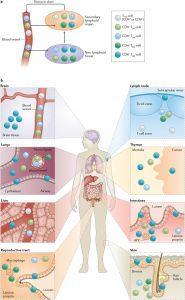CD8+ T cells have become a cell type of growing interest due to researchers wanting to understand how the immune system responds to cancers and pathogens. CD8+ T cells are activated in response to infection and cancer, as well as harbouring the ability to remember these foreign pathogens and malignant tissues.
In a recent paper by Crowl, et al., researchers provide novel insights into CD8+ tissue-resident memory T cells (Figure 1). They have described how these cells adapt when present within specific environments, differing from one another. Through identification of specific transcriptional pathways and regulators, they were able to develop an atlas capable of describing this cell type in different tissues allowing for the improved and more informed design of vaccines.

Figure 1: Localization and migration of memory T cells in tissues (Meuller, et al., 2015)
In this paper they looked at tissue-resident T cells in mice, specifically looking at their development in the kidney, spleen, small intestine, and liver. This description of T cell populations within diverse environments, offers a unique picture of this cell type.
This work opens the door for possible personalised engineering of the immune response localised to specific/certain tissue.
Journal article: Crowl, J.T., et al. 2022. Tissue-resident memory CD8+ T cells possess unique transcriptional, epigenetic and functional adaptations to different tissue environments. Nature Immunology.
Summary by Stefan Botha










